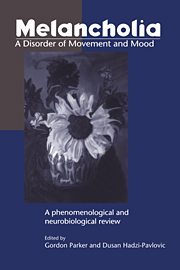Book contents
- Frontmatter
- Contents
- List of contributors
- Acknowledgments
- Introduction
- Part One Classification and Research: Historical and Theoretical Aspects
- Part Two Development and Validation of a Measure of Psychomotor Retardation as a Marker of Melancholia
- Part Three The Neurobiology of Melancholia
- 15 Melancholia as a Neurological Disorder
- 16 Melancholia and the Ageing Brain
- 17 Magnetic Resonance Imaging in Primary and Secondary Depression
- 18 Functional Neuroimaging in Affective Disorders
- 19 Summary and Conclusions
- The CORE Measure: Procedural Recommendations and Rating Guidelines
- References
- Author Index
- Subject Index
19 - Summary and Conclusions
from Part Three - The Neurobiology of Melancholia
Published online by Cambridge University Press: 04 August 2010
- Frontmatter
- Contents
- List of contributors
- Acknowledgments
- Introduction
- Part One Classification and Research: Historical and Theoretical Aspects
- Part Two Development and Validation of a Measure of Psychomotor Retardation as a Marker of Melancholia
- Part Three The Neurobiology of Melancholia
- 15 Melancholia as a Neurological Disorder
- 16 Melancholia and the Ageing Brain
- 17 Magnetic Resonance Imaging in Primary and Secondary Depression
- 18 Functional Neuroimaging in Affective Disorders
- 19 Summary and Conclusions
- The CORE Measure: Procedural Recommendations and Rating Guidelines
- References
- Author Index
- Subject Index
Summary
As we have presented our arguments and empirical analyses in some detail in the preceding chapters, this will be a succinct overview of the issues and conclusions.
We have noted (Chapters 1–3) some major limitations to recent and current formal classifications of the depressive disorders, particularly limitations in a number of assumptions, which, by forcing homogeneity across heterogeneous conditions, almost certainly provide invalid definitions of melancholia. As a corollary, such limitations have restricted identification and quantification of aetiological factors and of treatment specificity to separate depressive disorders to an extent that prejudices treatment. Such limitations restrict the application of the increasingly sophisticated tools and technologies now available to the biological psychiatrist. Strauss (1994) has similarly questioned whether biological psychiatry is building on an adequate base. He stated that it now seems that “with impressive and increasing sophistication in the neurosciences, we are leaving patient description far behind.” He argued that “current categories” may have been adequate to begin to understand disorders, but that “such categories may reflect simplistic, static notions that relate only very approximately to the core processes involved in psychopathology.” Further, he suggested that if we refuse to attend to the phenomena that reflect core processes, “Biology is going to be severely handicapped in finding biological connections to psychopathologic mechanisms.” Such concerns underpinned our research objectives and have therefore been detailed extensively.
Viewing melancholia as a psychiatric disorder highly amenable to circumscription, we have sought to identify its denning clinical features.
- Type
- Chapter
- Information
- Melancholia: A Disorder of Movement and MoodA Phenomenological and Neurobiological Review, pp. 277 - 281Publisher: Cambridge University PressPrint publication year: 1996



